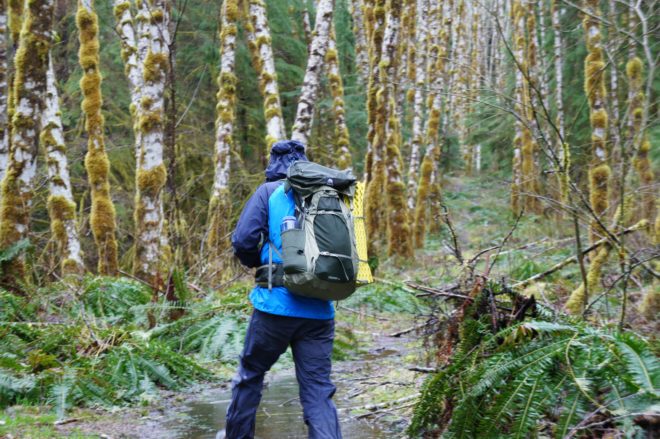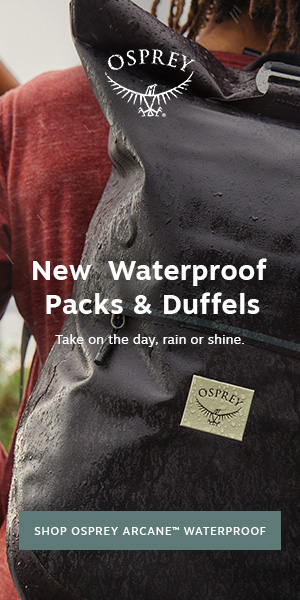What Makes a Great Outdoor Pack?
With all of the buying guides out there, you’d think there would be a straightforward answer for what it takes to turn a good outdoor pack into a great outdoor pack. Unfortunately, it’s such a personal subject that it’s hard to produce a definitive list, so we tried to keep this one simple.
First and foremost, it has to be comfortable.
Being outside can challenge you not only physically, but also mentally and emotionally. The last thing you want to deal with is equipment that hinders your experience and/or your mission. For me, that’s moving from point A to B gracefully and with intention. I don’t want to use any additional energy adjusting my load carriage trying to mitigate any undue fatigue and discomfort my system creates.

This Granite Gear Kahiltna has one of the plushest suspension systems I’ve ever worn. That makes it an easy pick for a cold weather day hike.
A bag has to have a viable suspension system. Anything that holds the bag to your body has to be well considered. An awesome pack will carry a half load as well as it does an over-load. Are the shoulder straps easy to get in and out of? Does the hip belt evenly distribute weight? Does the frame drive the weight into your lumbar and provide a rigid loading platform for heavier outings? I’m always looking for ways to travel through the backcountry more comfortably, and how my pack rides is the first thing I consider.
It has to make sense.
In line with comfort is design. A pack should support you and add value to your experience. If it’s poorly designed, if the features aren’t well thought out, if the actual end user isn’t kept in mind, it shows. I hate getting my hopes up by potentially great bags only to be let down by a “What? Why would they do that? That doesn’t make any sense,” design oversight.

One of my favorite outdoor packs is the Ultimate Direction A.K. Mountain Vest 3.0. Killer pocket placement gives you access to everything you need for a day on the trails without ever taking the pack off.
I’ve abraded too many face fabrics because of rogue hook panels that have adjusted out of place of their corresponding loop panels and seen too many accessory pockets rendered useless from overlaying compression straps. R&D. R&D. R&D.
The last thing you want to deal with is equipment that hinders your experience and/or your mission. For me, that’s moving from point A to B gracefully and with intention.
Pocket placement and size, zipper orientation, compression strap location, access choices: every decision the design team makes tells a story. That story has to make sense, and as consumers, we have to buy into it. Design choices that create excitement add value to our experiences. Being excited brings us closer to the brand and lays the foundation for a good relationship with the bag, and that’s important because we end up spending a lot of time with our outdoor bags.

The Crown2’s simple design, with three exterior pockets and one in the lid, keeps everything nice and orderly in the pack and in my head.
Further, I should say that additional features do not equal additional value. Feature-rich bags are great—but there’s a lot to be said for simplicity.
It has to be versatile.
Versatility is born from good design. Climbers, skiers, and all the other breeds of dirt bags are super resourceful folks. Mission-specific bags are awesome, but they can also box you in.
Draw up a sub 2kg pack with a workhorse suspension, throw two columns of daisy chain down the front, create a smart and flexible compression system to hold a bunch of awesome stuff on the outside, add a few stretch woven stash pockets, and sprinkle a few smaller organizational pockets throughout. We’ll figure out the rest.

A loaded up pre-release Crown2 proved to be flexible when I wanted to run the top lid as a chest pack.
Durability, warranty, and customer service.
Blown seams, chintzy hardware, cheap fabrics…blah. There are no shortcuts to quality. I’m not particularly hard on my stuff, but I use it, and sometimes the environment gets the better of my gear.

The Mystery Ranch Stein 62 is made out of a 400D nylon, which I’ve found to be durable enough in the PNW, Canyonlands, and Appalachia most recently.
A lot of the time, it’s user error, like dropping a pack on chossy granite and ending up with small holes in the bottom of your pack and wand pockets. That’s not a big deal to me, but major components need to endure. The main pack bag’s integrity, the suspension, and the compression should last for the reasonable lifespan of the pack.
I don’t buy anything for serious outdoor use that doesn’t come with a lifetime warranty. That’s pretty standard protocol for me. If I’m going to go out on a limb and try a new system and spend my money on a product that I’m going to rely on in a wilderness environment, it better be covered by the manufacturer. A solid customer service team of experienced outdoorsmen and women doesn’t hurt either.

The Mountain Standard 28L Utility Pack was one of the more bomber bags I’ve ever test driven. A 500D, urethane-coated nylon body and Hypalon bottom panel make it an excessively tough pack.
Great outdoor bags have personality.
It’s hard to place my finger on it, but there’s something about a great pack that just speaks to you. It wants to be worn. We file this under the X-factor in our reviews. Sometimes I look at bags the same way I look at cars and what they symbolize, and I ask myself, “Would I want to drive that?” If it doesn’t raise your heart rate or make you daydream about adventure, is it even worth it?
Additional features don’t always equal additional value. Feature-rich bags are great—but there’s a lot to be said for simplicity.
Features that I look for?
I really like removable top lids and beaver tails or compression panels. Versatility for me is a really big deal, and both these features do a lot in terms of keeping me adaptable.
A removable top lid allows me to stash something between the main pack compartment and the lid. It also serves as a ditty bag for me to take into the tent at the end of the night.

The Gregory Denali 75 top lid serves as a great in-shelter organizer for my personal items when it’s too cold to rifle through the main pack bag in the middle of the night.
Beaver tails/compression panels are great because they can again be used to hold additional items outside the main pack bag and provide additional organization.

The beaver tail and removable lid on the Granite Gear Leopard A.C. 58 make it one of the more versatile packs I’ve owned.
Again, there’s no definitive list to characteristics of truly epic outdoor packs. If you’ve got your own criteria list and we missed something, comment below and add to the conversation. To get you started on finding your own great outdoor pack, here’s a few brands we’re digging right now: Hill People Gear, Seek Outside and Granite Gear.
Keen on more handy outdoor insights and advice? Check out Ace-Outside on Facebook and Twitter.





 Carry Awards
Carry Awards Insights
Insights Liking
Liking Projects
Projects Interviews
Interviews












